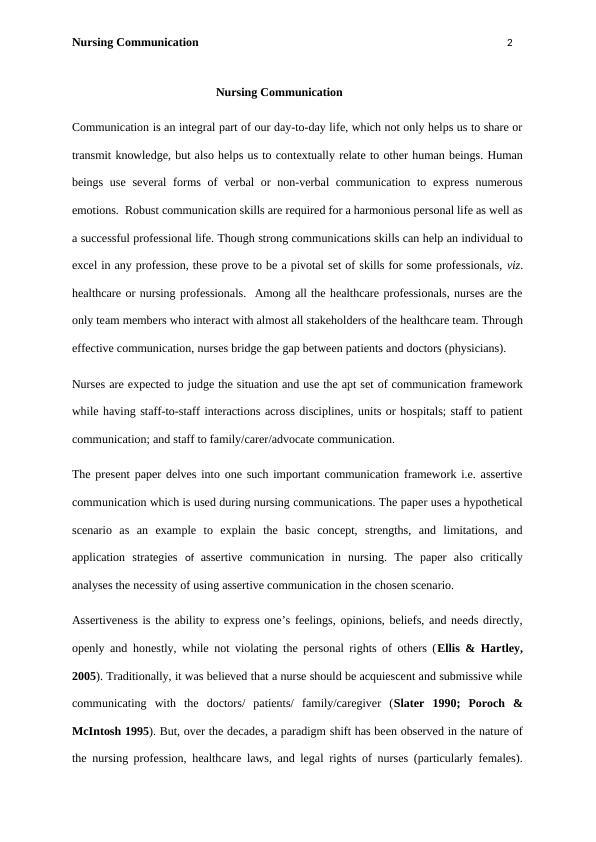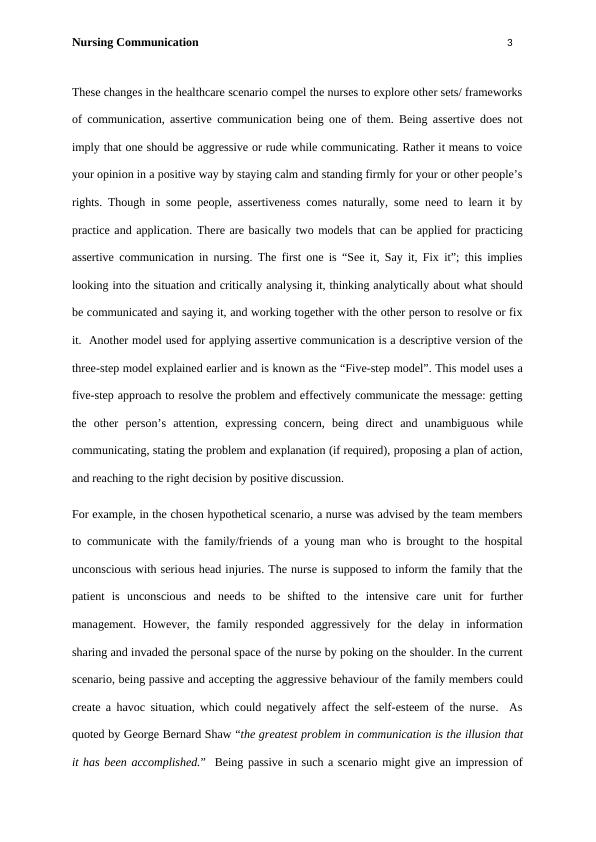Nursing Communication
Added on 2023-04-04
8 Pages1915 Words309 Views
Nursing Communication 1
Nursing Communication
Student's Name:
Instructor's Name:
Date:
Nursing Communication
Student's Name:
Instructor's Name:
Date:

Nursing Communication 2
Nursing Communication
Communication is an integral part of our day-to-day life, which not only helps us to share or
transmit knowledge, but also helps us to contextually relate to other human beings. Human
beings use several forms of verbal or non-verbal communication to express numerous
emotions. Robust communication skills are required for a harmonious personal life as well as
a successful professional life. Though strong communications skills can help an individual to
excel in any profession, these prove to be a pivotal set of skills for some professionals, viz.
healthcare or nursing professionals. Among all the healthcare professionals, nurses are the
only team members who interact with almost all stakeholders of the healthcare team. Through
effective communication, nurses bridge the gap between patients and doctors (physicians).
Nurses are expected to judge the situation and use the apt set of communication framework
while having staff-to-staff interactions across disciplines, units or hospitals; staff to patient
communication; and staff to family/carer/advocate communication.
The present paper delves into one such important communication framework i.e. assertive
communication which is used during nursing communications. The paper uses a hypothetical
scenario as an example to explain the basic concept, strengths, and limitations, and
application strategies of assertive communication in nursing. The paper also critically
analyses the necessity of using assertive communication in the chosen scenario.
Assertiveness is the ability to express one’s feelings, opinions, beliefs, and needs directly,
openly and honestly, while not violating the personal rights of others (Ellis & Hartley,
2005). Traditionally, it was believed that a nurse should be acquiescent and submissive while
communicating with the doctors/ patients/ family/caregiver (Slater 1990; Poroch &
McIntosh 1995). But, over the decades, a paradigm shift has been observed in the nature of
the nursing profession, healthcare laws, and legal rights of nurses (particularly females).
Nursing Communication
Communication is an integral part of our day-to-day life, which not only helps us to share or
transmit knowledge, but also helps us to contextually relate to other human beings. Human
beings use several forms of verbal or non-verbal communication to express numerous
emotions. Robust communication skills are required for a harmonious personal life as well as
a successful professional life. Though strong communications skills can help an individual to
excel in any profession, these prove to be a pivotal set of skills for some professionals, viz.
healthcare or nursing professionals. Among all the healthcare professionals, nurses are the
only team members who interact with almost all stakeholders of the healthcare team. Through
effective communication, nurses bridge the gap between patients and doctors (physicians).
Nurses are expected to judge the situation and use the apt set of communication framework
while having staff-to-staff interactions across disciplines, units or hospitals; staff to patient
communication; and staff to family/carer/advocate communication.
The present paper delves into one such important communication framework i.e. assertive
communication which is used during nursing communications. The paper uses a hypothetical
scenario as an example to explain the basic concept, strengths, and limitations, and
application strategies of assertive communication in nursing. The paper also critically
analyses the necessity of using assertive communication in the chosen scenario.
Assertiveness is the ability to express one’s feelings, opinions, beliefs, and needs directly,
openly and honestly, while not violating the personal rights of others (Ellis & Hartley,
2005). Traditionally, it was believed that a nurse should be acquiescent and submissive while
communicating with the doctors/ patients/ family/caregiver (Slater 1990; Poroch &
McIntosh 1995). But, over the decades, a paradigm shift has been observed in the nature of
the nursing profession, healthcare laws, and legal rights of nurses (particularly females).

Nursing Communication 3
These changes in the healthcare scenario compel the nurses to explore other sets/ frameworks
of communication, assertive communication being one of them. Being assertive does not
imply that one should be aggressive or rude while communicating. Rather it means to voice
your opinion in a positive way by staying calm and standing firmly for your or other people’s
rights. Though in some people, assertiveness comes naturally, some need to learn it by
practice and application. There are basically two models that can be applied for practicing
assertive communication in nursing. The first one is “See it, Say it, Fix it”; this implies
looking into the situation and critically analysing it, thinking analytically about what should
be communicated and saying it, and working together with the other person to resolve or fix
it. Another model used for applying assertive communication is a descriptive version of the
three-step model explained earlier and is known as the “Five-step model”. This model uses a
five-step approach to resolve the problem and effectively communicate the message: getting
the other person’s attention, expressing concern, being direct and unambiguous while
communicating, stating the problem and explanation (if required), proposing a plan of action,
and reaching to the right decision by positive discussion.
For example, in the chosen hypothetical scenario, a nurse was advised by the team members
to communicate with the family/friends of a young man who is brought to the hospital
unconscious with serious head injuries. The nurse is supposed to inform the family that the
patient is unconscious and needs to be shifted to the intensive care unit for further
management. However, the family responded aggressively for the delay in information
sharing and invaded the personal space of the nurse by poking on the shoulder. In the current
scenario, being passive and accepting the aggressive behaviour of the family members could
create a havoc situation, which could negatively affect the self-esteem of the nurse. As
quoted by George Bernard Shaw “the greatest problem in communication is the illusion that
it has been accomplished.” Being passive in such a scenario might give an impression of
These changes in the healthcare scenario compel the nurses to explore other sets/ frameworks
of communication, assertive communication being one of them. Being assertive does not
imply that one should be aggressive or rude while communicating. Rather it means to voice
your opinion in a positive way by staying calm and standing firmly for your or other people’s
rights. Though in some people, assertiveness comes naturally, some need to learn it by
practice and application. There are basically two models that can be applied for practicing
assertive communication in nursing. The first one is “See it, Say it, Fix it”; this implies
looking into the situation and critically analysing it, thinking analytically about what should
be communicated and saying it, and working together with the other person to resolve or fix
it. Another model used for applying assertive communication is a descriptive version of the
three-step model explained earlier and is known as the “Five-step model”. This model uses a
five-step approach to resolve the problem and effectively communicate the message: getting
the other person’s attention, expressing concern, being direct and unambiguous while
communicating, stating the problem and explanation (if required), proposing a plan of action,
and reaching to the right decision by positive discussion.
For example, in the chosen hypothetical scenario, a nurse was advised by the team members
to communicate with the family/friends of a young man who is brought to the hospital
unconscious with serious head injuries. The nurse is supposed to inform the family that the
patient is unconscious and needs to be shifted to the intensive care unit for further
management. However, the family responded aggressively for the delay in information
sharing and invaded the personal space of the nurse by poking on the shoulder. In the current
scenario, being passive and accepting the aggressive behaviour of the family members could
create a havoc situation, which could negatively affect the self-esteem of the nurse. As
quoted by George Bernard Shaw “the greatest problem in communication is the illusion that
it has been accomplished.” Being passive in such a scenario might give an impression of

End of preview
Want to access all the pages? Upload your documents or become a member.
Related Documents
Report on Nursing Communication (pdf)lg...
|8
|2582
|288
Assertiveness in Nurses - Assignmentlg...
|8
|1887
|232
Literacies and Communication for Healthcare PDFlg...
|7
|1781
|111
Demonstrate an Understanding of the Professional 2022lg...
|4
|1257
|16
Effective Communication Strategies in Nursing: Verbal and Non-Verbal Communication, Barriers, and Legal and Ethical Frameworklg...
|7
|2026
|142
Nursing Assignment: Person Centered Care and Ethical Code of Conducts for Aboriginal Patientslg...
|8
|2068
|268
